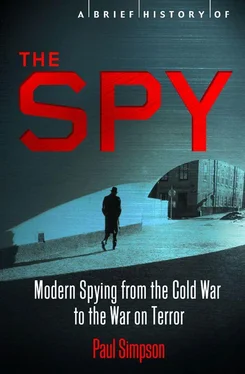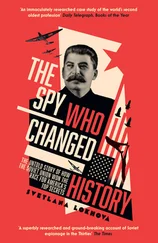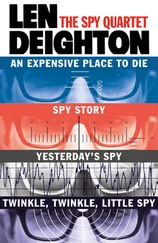Paul Simpson - A Brief History of the Spy
Здесь есть возможность читать онлайн «Paul Simpson - A Brief History of the Spy» весь текст электронной книги совершенно бесплатно (целиком полную версию без сокращений). В некоторых случаях можно слушать аудио, скачать через торрент в формате fb2 и присутствует краткое содержание. Город: London, Год выпуска: 2013, ISBN: 2013, Издательство: Constable & Robinson, Жанр: Прочая документальная литература, на английском языке. Описание произведения, (предисловие) а так же отзывы посетителей доступны на портале библиотеки ЛибКат.
- Название:A Brief History of the Spy
- Автор:
- Издательство:Constable & Robinson
- Жанр:
- Год:2013
- Город:London
- ISBN:9781780338910
- Рейтинг книги:3 / 5. Голосов: 1
-
Избранное:Добавить в избранное
- Отзывы:
-
Ваша оценка:
- 60
- 1
- 2
- 3
- 4
- 5
A Brief History of the Spy: краткое содержание, описание и аннотация
Предлагаем к чтению аннотацию, описание, краткое содержание или предисловие (зависит от того, что написал сам автор книги «A Brief History of the Spy»). Если вы не нашли необходимую информацию о книге — напишите в комментариях, мы постараемся отыскать её.
A Brief History of the Spy — читать онлайн бесплатно полную книгу (весь текст) целиком
Ниже представлен текст книги, разбитый по страницам. Система сохранения места последней прочитанной страницы, позволяет с удобством читать онлайн бесплатно книгу «A Brief History of the Spy», без необходимости каждый раз заново искать на чём Вы остановились. Поставьте закладку, и сможете в любой момент перейти на страницу, на которой закончили чтение.
Интервал:
Закладка:
In the early nineties, having been thrown out of Saudi Arabia, bin Laden moved to Sudan, where he set up training camps for warriors in a ‘jihad’. One of the first attacks linked to the group was that on the World Trade Center in 1993, when six people were killed and more than a thousand injured by a 500 kg bomb planted in the parking lot. Behind that attack was Ramzi Yousef, the nephew of Khalid Sheikh Mohammed, who in turn claimed to be the instigator of 9/11. (A British security expert based at the World Trade Center, Rick Rescorla, had reported that the parking lot was an obvious target for terrorists two years earlier; this was ignored, as was his subsequent report that the WTC would be attacked from the air. Rescorla lost his life escorting people out of the South Tower on 9/11.)
Al-Qaeda was linked to the downing of two Black Hawk helicopters in Somalia in 1993, as well as the June 1996 bomb at the Khobar Towers, an American military housing complex near Dhahran in Saudi Arabia, which killed nineteen Americans. Shortly before this, bin Laden moved from Sudan to Afghanistan and in September 1996, called on his followers to ‘launch a guerrilla war against American forces and expel the infidels from the Arabian Peninsula’. A further fatwa (an Islamic legal pronouncement) was issued on 22 February 1998, by bin Laden and four of his associates in the name of the ‘World Islamic Front for Jihad Against Jews and Crusaders’, calling for the killing of Americans, saying it is the ‘individual duty for every Muslim who can do it in any country in which it is possible to do it’. Six months later, 225 people were killed, and over four thousand wounded, when bombs were driven into American embassies in Kenya and Tanzania, which led to airstrikes by the US against al-Qaeda positions in Afghanistan and Sudan. Bin Laden was indicted in the US courts for these attacks. In October 2000, two suicide attackers rammed a boat carrying explosives into the USS Cole near the Yemeni port of Aden, killing seventeen sailors and wounding forty others.
Those weren’t the only attacks linked to al-Qaeda in the nineties by the world’s intelligence services. The 1992 bombing of the Gold Mihor Hotel in Aden and the Luxor Massacre of November 1997 were both al-Qaeda funded operations, while a triple strike planned for January 2000 was foiled by the arrest of the Jordanian cell responsible for one part; the destruction of a skiff planned to sink USS The Sullivans in Yemen; and the arrest of the bomber who was going to set off a device at Los Angeles International Airport.
All this came at a time when the role of the intelligence agencies worldwide was being questioned. The sudden and dramatic end of the Cold War had left many wondering if countries needed secret services such as the CIA or MI6. In Britain, it was decided that the existence of MI6 would be revealed publicly, which, as the then-head of service Sir Colin McColl pointed out, many believed would be the start of a ‘slippery slope… Our work is about trust; trust between government and people running the service; and the service and people all over the world working for it,’ he told a BBC Radio documentary celebrating a hundred years of MI6 in 2009. In the end, what the Intelligence Services Act in 1994 did was simply confirm the services’ existence, but didn’t go into any form of operational detail. A team of management consultants were brought into MI6, who slimmed the service down considerably.
Similar events were happening at MI5, with the first female Director-General, Stella Rimington, taking a much more public role. Consideration was given in 1994 to amalgamating the two services, but this was not implemented. A disaffected MI5 officer, David Shayler, tried to emulate Peter Wright with revelations about the service’s activities (even appearing on light-entertainment programme Have I Got News For You ) but like Wright, showed more about his own deficiencies and faults than those of MI5.
President Clinton’s incoming DCI R. James Woolsey, who succeeded Robert Gates, told his confirmation hearings in 1992 that he was considering alternate activities for the CIA, such as possibly sharing their business intelligence with private companies. As he pointed out, the West had ‘slain a large dragon’, but still lived ‘in a jungle filled with a bewildering variety of poisonous snakes’. There was more intelligence sharing with old enemies — particularly over such issues as the whereabouts of nuclear missiles and other materiel that might have fallen into terrorists’ hands after the breakup of the Soviet Union. ‘We are partners now,’ the chief spokesman of the FSB, the Russian Foreign Intelligence Service, Yuri Kobaladze said in an interview, ‘although it will take some time to find the right way to deal with each other. We have universal problems like proliferation and international terrorism. These are our enemies. That’s why we have to cooperate with the US and the rest of the world.’
For spies, the ground rules had changed. During the Cold War, spies operating undercover in a foreign country could normally expect interrogation and imprisonment followed by the likelihood of exchange (although of course there was always the chance of execution). Former Deputy DCI Admiral Bobby Ray Inman explained in 1993 that terrorists and the drug-traffickers didn’t play by those ‘gentlemanly’ rules. ‘When you try to penetrate them and they suspect you, they don’t put you in jail. They shoot.’
CIA morale was hit by the cost-cutting insisted on by the administration — although the plans were only for it to revert to the size it had been during the Carter presidency — and even more by the revelation of Aldrich Ames’ treachery. Despite the KGB being wound up when the Soviet Union was dissolved, Ames’ loyalty had continued to be to his Russian paymasters, and he gladly provided material to the SVR.
The CIA had suspected there was a mole as early as 1986, and Jeanne Vertefeuille (often likened to John le Carré’s fictional obsessed researcher Connie Sachs from Tinker, Tailor, Soldier, Spy ) was placed in charge of the investigation, although it was given no priority. Ames was posted to Rome between 1986 and 1989, and did not have a very distinguished career. When he returned, he was assigned to the counterintelligence centre and was therefore able to pass Moscow all the details of the CIA’s actions against the KGB and then the SVR. Suspicions about his spending habits had been voiced and eventually a joint task force was set up with the FBI. The Bureau took over the case in May 1993 and arrested Ames in February 1994. (Ames’ handler Victor Cherkashin believes that Ames and later Robert Hanssen were actually betrayed by a CIA spy within the SVR.)
R. James Woolsey came in for a great deal of criticism over his attitude to the discovery — although verbal reprimands were issued to eleven key staff members (some of whom were retired), no one was fired over the Ames affair. However, the Senate Intelligence Committee called this response ‘seriously inadequate’ for a ‘disaster of unprecedented proportions’. Woolsey resigned in December 1994. He was replaced by Deputy Defence Secretary John Deutch, who continued Woolsey’s policy of declassifying documents relating to the Cold War, and trying to broaden the Agency’s personnel base with more women and minorities (a class action case had been brought against the Agency by various female employees during Woolsey’s time). For the first time since William Casey’s tenure, the DCI was a member of the cabinet, giving him more access to the president. He also brought in new management, in an effort to spring-clean the Agency.
The CIA’s public image suffered further during the mid-nineties when it was revealed that they were continuing to supply aid to Guatemalan military intelligence, despite an instruction in 1992 to sever ties, and were possibly complicit in the deaths of two Americans; this was seen as a continuation of now-outdated Cold War policies and further evidence that the Agency wasn’t moving with the times — as one former agent told Time magazine: ‘If you were going to pick a place where the CIA still has a cowboy mentality, it’s there.’ An internal probe found that the Agency had indeed covered up the deaths.
Читать дальшеИнтервал:
Закладка:
Похожие книги на «A Brief History of the Spy»
Представляем Вашему вниманию похожие книги на «A Brief History of the Spy» списком для выбора. Мы отобрали схожую по названию и смыслу литературу в надежде предоставить читателям больше вариантов отыскать новые, интересные, ещё непрочитанные произведения.
Обсуждение, отзывы о книге «A Brief History of the Spy» и просто собственные мнения читателей. Оставьте ваши комментарии, напишите, что Вы думаете о произведении, его смысле или главных героях. Укажите что конкретно понравилось, а что нет, и почему Вы так считаете.












